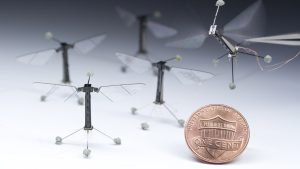
BY TAYLOR LOGAN
Pollinators are in danger of extinction, and without pollinators we might be next.
But scientists might have found a unique solution – pollinator drones.
Studies around the world, from the Wyss Institute of Harvard University in Boston, to National Institute of Advanced Industrial Science and Technology (NIAIST) in Japan, have found the possibility of using tiny, flying robots to pollinate crops worldwide, and take some weight off of bees shoulders.
According to a paper written by NIAIST researchers, “Recent advances in bio-inspired robotics promise to bridge the performance gap with respect to animals. Among the various bio-inspired robots being developed, aerial robots represent a class of emerging robotics with the expectation of solving the issues arising from the global decline in the population of honeybees, which are normally involved in the pollination of plants.”
The vision of Eijjiro Miyako, the head of pollinator drone research at NIAIST, began over three years ago. Accidentally making a sticky gel in a lab failure eight years prior, Miyako discovered the still viable gel during a lab clean up in 2015. This sparked further research, and hearing about the decline in honeybees, and the research done by Harvard, Miyako decided to take charge. He began by testing the gel on ants, finding the gel to be perfect for transferring pollen, and later moved on to making the nanobots themselves.
“The findings described here … should lead to the development of robotic pollinators and help counter the problems caused by the declining honeybee populations,” Miyako’s team wrote in the paper.
This is the first step in creating a solution to the ailing pollinator population. They believe through artificial intelligence and GPS, these little drones will be pollinating in no time.
But Elizabeth Elle, biology professor at Simon Fraser University and pollinator expert, believes it will never work.
“In agricultural situations, hundreds of thousands of honeybees are placed on a crop in bloom, to supplement the local population of native pollinators. If you google images of almond fields or blueberry fields in bloom, you will see just how many flowers need to be pollinated,” Elle said, “I don’t see that it would ever be cost effective to deploy enough drones to do the job, even if they could be made so they are effective at moving pollen, to my knowledge there is still work to be done there!”
And YuFeng Chen, PhD and researcher of the RoboBee at Wyss Institute agrees.
“We don’t expect the RoboBees to replace bees in the future. There are many reasons. From a cost perspective, building a swarm of RoboBees is much more expensive to raising a colony of bees. More importantly, there are tasks that bees can do that the robot will not be able to, for example, making honey.” Chen said. “We see insects as a good source of inspiration for us to build robots, and the goal is to achieve new functions in our robots that are absent in traditional robotics. We also hope our robots can help to investigate insect biomechanics questions. We have no intention, nor it is practical, to replace any insect with our robots.”
Harvard University began its research over a decade ago. Funded by the United States Defense Advanced Research Projects Agency, the RoboBee has been through three generations already, and has shrunk down to the size of a paperclip. But it is believed it will be a while longer before they come to the mainstream.
“Thus far it has been primarily a research project. We do not expect it to be commercialized in the short term. Personally, I feel that we need at least 5 to 10 years of continual development. The main challenges are putting power source, flight controller, and sensors onboard this tiny vehicle.” Chen said.
But Harvard has other plans for the RoboBee.
After they achieve the goal of utilizing swarm intelligence, Harvard plans on using the drones in natural disasters and wars, as a search and rescue tool. The bots have the ability to stick to walls and dive into water, and being so small, the nanobots will be able to manoeuvre through tight spaces to find people in places that rescue teams couldn’t get to.
The RoboBees will also be able to detect harmful chemicals in places humans can’t go, and provide covert surveillance to the military.
Although this future is far away, the NIAIST and Harvard university has nano plans to make a big change.
